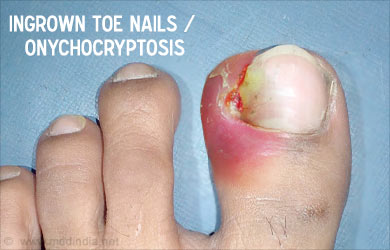
There are many causes of ingrown toenails. If you are one of these people, you’re at higher risk than most people. Most of the time, these are caused by wearing tight, narrow shoes or wearing shoes that rub on your toes. Other factors may increase your risk, including genetics, poor circulation, and diabetes, which can lead to the growth of your nails in the wrong place. Obesity can also cause ingrown toenails.
Initially, you may notice some swelling and redness around the point of the ingrown nail. Pain may be significant, but it will subside in a few days. If you’re experiencing pain, apply a cold compress to the affected area. You can also apply ice to the area. If the pain is unbearable, consider having a doctor examine you. You may need to have surgery to correct the condition, but most ingrown toenails do not require any medical treatment.
You may also want to visit your doctor to get a professional diagnosis. The symptoms of an ingrown toenail vary from person to person. However, you should always consult a physician for treatment if your symptoms persist and do not improve with home remedies. Eventually, you may need surgery. It’s important to seek medical attention as soon as possible if you’re suffering from an ingrown toenail.
A doctor can diagnose and treat ingrown toenails. Most cases can be treated quickly in the office. Patients can return to normal activity afterward. After the procedure, the wound may be infected and require antibiotics. An infection may also occur. If your ingrown toenail has spread, you should see a doctor as soon as possible. The infection can become very serious. You should see a podiatrist as soon as you can.
Ingrown toenails are common and can be very painful. You may experience swollen, red, and tender skin on your toe. During this time, your toe may be numb and may even have pus. If you have an ingrown toenail, it is essential to see a podiatrist as soon as possible. If your toe is infected, antibiotic cream and rest can help relieve the pain.

The first step in treating ingrown toenails is to see a doctor as soon as you notice noticeable swelling or redness in your toe. You may also experience swelling or a red, discolored toe and may need surgery. You can use dental floss to remove an ingrown toenail. If you don’t have a doctor, you can try the home remedies listed on the site https://phuketbulletin.co.th/. If you don’t have time to see a doctor, your ingrown toenails can be painful and need to be removed.
You must take action to stop the pain. You should avoid wearing shoes that rub your toes and keep your feet as high as possible. While this may be a temporary solution, it can lead to a more serious infection. If an ingrown toenail appears, you should immediately consult a doctor. There are many ways to treat ingrown toenails and prevent infection.
Ingrown toenails can be painful and need immediate medical treatment to prevent further complications. If you’re experiencing pain, swelling, and redness, it’s important to see a doctor. If the problem is more severe, you may need to undergo surgery. Ingrown toenails are painful, but if you don’t feel any pain, you should consult a doctor immediately. If you can’t bear the pain, you can try some home remedies to relieve the symptoms.
If you’re experiencing ingrown toenails symptoms, you should visit a doctor right away. The most effective treatment for ingrown toenails is a combination of home treatments and a trip to the doctor. If your symptoms are severe, you may need to undergo surgery. It will be difficult for you to walk for a short time without any pain. Ingrown toenails are painful and can cause other problems, including cellulitis and an infection of the bone beneath the toenail.
Besides preventing ingrown toenails, it’s important to wear proper footwear. Your shoes should be roomy and comfortable. You should also wear thick socks to prevent pressure on your toes. It’s best to wear sturdy shoes with soft soles. You can even opt for steel-toed boots if you’re at risk of getting ingrown toenails. You should avoid any type of inflammatory skin on your toes, as this can lead to infections.